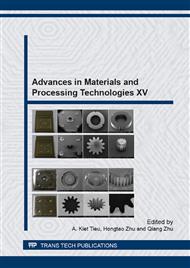[1]
S. Lee, R. Iten, M. Muller, N. D. Spencer, Influence of molecular architecture on the adsorption of poly(ethylene oxide)-poly(propylene oxide)-poly(ethylene oxide) on PDMS surfaces and implications for aqueous lubrication, Macromolecules. 37 (2004) 8349-8356.
DOI: 10.1021/ma049076w
Google Scholar
[2]
Y. B. Liou, R. Y. Tsay, Adsorption of PEO-PPO-PEO triblock copolymers on a gold surface, J Taiwan Inst Chem E. 42 (2011) 533-540.
DOI: 10.1016/j.jtice.2010.09.011
Google Scholar
[3]
F. Tiberg, M. Malmsten, P. Linse, B. Lindman, Kinetic and Equilibrium Aspects of Block Copolymer Adsorption, Langmuir. 7 (1991) 2723-2730.
DOI: 10.1021/la00059a053
Google Scholar
[4]
M. Malmsten, P. Linse, T. Cosgrove, Adsorption of Peo Ppo Peo Block Copolymers at Silica, Macromolecules. 25 (1992) 2474-2481.
DOI: 10.1021/ma00035a028
Google Scholar
[5]
H. W. Shi, S. J. Zhang, R. Steitz, J. Q. Chen, S. Uredat, G. H. Findenegg, Surface coatings of PEO-PPO-PEO block copolymers on native and poly styrene-coated silicon wafers, Colloid Surface A. 246 (2004) 81-89.
DOI: 10.1016/j.colsurfa.2004.07.019
Google Scholar
[6]
P. Brandani, P. Stroeve, Adsorption and desorption of PEO-PPO-PEO triblock copolymers on a self-assembled hydrophobic surface, Macromolecules. 36 (2003) 9492-9501.
DOI: 10.1021/ma0342675
Google Scholar
[7]
X. Liu, D. Wu, S. Turgman-Cohen, J. Genzer, T. W. Theyson, O. J. Rojas, Adsorption of a Nonionic Symmetric Triblock Copolymer on Surfaces with Different Hydrophobicity, Langmuir. 26 (2010) 9565-9574.
DOI: 10.1021/la100156a
Google Scholar
[8]
R. J. Green, S. Tasker, J. Davies, M. C. Davies, C. J. Roberts, S. J. B. Tendler, Adsorption of PEO-PPO-PEO triblock copolymers at the solid/liquid interface: A surface plasmon resonance study, Langmuir. 13 (1997) 6510-6515.
DOI: 10.1021/la962098u
Google Scholar
[9]
P. Brandani, P. Stroeve, Kinetics of adsorption and Desorption of PEO-PPO-PEO triblock copolymers on a self-assembled hydrophobic surface, Macromolecules. 36 (2003) 9502-9509.
DOI: 10.1021/ma034268x
Google Scholar
[10]
A. R. Statz, J. H. Kuang, C. L. Ren, A. E. Barron, I. Szleifer, P. B. Messersmith, Experimental and theoretical investigation of chain length and surface coverage on fouling of surface grafted polypeptoids, Biointerphases. 4 (2009) Fa22-Fa32.
DOI: 10.1116/1.3115103
Google Scholar
[11]
J. L. Dalsin, L. J. Lin, S. Tosatti, J. Voros, M. Textor, P. B. Messersmith, Protein resistance of titanium oxide surfaces modified by biologically inspired mPEG-DOPA, Langmuir. 21 (2005) 640-646.
DOI: 10.1021/la048626g
Google Scholar
[12]
K. J. Rosenberg, T. Goren, R. Crockett, N. D. Spencer, Load-Induced Transitions in the Lubricity of Adsorbed Poly(L-lysine)-g-dextran as a Function of Polysaccharide Chain Density, Acs Appl Mater Inter. 3 (2011) 3020-3025.
DOI: 10.1021/am200521m
Google Scholar
[13]
L. M. Feller, S. Cerritelli, M. Textor, J. A. Hubbell, S. G. P. Tosatti, Influence of poly(propylene sulfide-block-ethylene glycol) di-and triblock copolymer architecture on the formation of molecular adlayers on gold surfaces and their effect on protein resistance: A candidate for surface modification in biosensor research, Macromolecules. 38 (2005) 10503-10510.
DOI: 10.1021/ma051424m
Google Scholar
[14]
Q. Lin, E. E. Meyer, M. Tadmor, J. N. Israelachvili, T. L. Kuhl, Measurement of the long- and short-range hydrophobic attraction between surfactant-coated surfaces, Langmuir. 21 (2005) 251-255.
DOI: 10.1021/la048317q
Google Scholar
[15]
Y. Li, H. Y. Liu, J. L. Song, O. J. Rojas, J. P. Hinestroza, Adsorption and Association of a Symmetric PEO-PPO-PEO Triblock Copolymer on Polypropylene, Polyethylene, and Cellulose Surfaces, Acs Appl Mater Inter. 3 (2011) 2349-2357.
DOI: 10.1021/am200264r
Google Scholar


